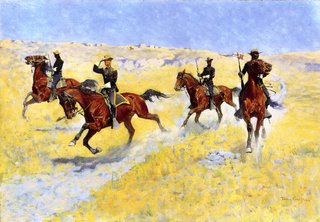The first painting is not particularly impressive on its technical merits, but the subject matter is interesting. Imagine such a scene today. Arresting a deserter. No doubt, the cameras would be out and the pieces sympathetic to the deserting soldier would be flooding the papers from coast to coast. Columnists would be demanding what is so horribly wrong with our military establishment that this fellow felt compelled to go AWOL?
Arresting the Deserter (1885)

This portrait of The Trooper, like some of the Indian portraits, is directly linked to our collective image of a cavalry officer – charging, full of confidence.
The Trooper (1892)

The Advance takes the portrait of the Trooper one step further, so far as action is concerned. The man in the lead appears to be the same officer. Does anything sit more erect in the saddle that a U.S. cavalry officer?
The Advance (1898)

This next picture, again, could’ve come directly from a John Ford picture. Some things are worth fighting for. In this case: water.
Fight for the Water Hole (1903)

This final picture looks like a Canadian Mountie, not a U.S. soldier, but regardless, he’s still done a bang up job getting his man.









.jpg)






1 comment:
You mention that one of the paintings looks like it comes right out of a John Ford Western. That would be because John Ford used Remington paintings as conceptual guides for his film compositions (and wisely so). But lets get one thing straight, Remington came long before John Ford.
Post a Comment